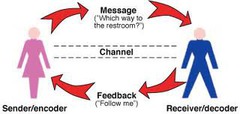Communication Process and Nonverbal Communication
0.0(0)
0.0(0)
New
Card Sorting
1/45
Earn XP
Description and Tags
Study Analytics
Name | Mastery | Learn | Test | Matching | Spaced |
|---|
No study sessions yet.
46 Terms
1
New cards
Glossophobia
fear of public speaking
2
New cards
Communication
the process of sharing information by using symbols to send and receive messages
3
New cards
interpersonal communication
communication between two or more people
4
New cards
intrapersonal communication
communication with oneself (internal); self-talk; where "YOU" are the messenger and receiver; we believe this more than what others say
5
New cards
verbal communication
expressing ideas to others by using spoken words
6
New cards
7%
percentage of communication that is verbal
7
New cards
93%
percentage of communication that is nonverbal
8
New cards
55%
percentage of nonverbal communication that is body language
9
New cards
38%
Percentage of nonverbal communication that is tonality (tone of voice)
10
New cards
Communication Process
the transfer of a message from a sender to a receiver, the feedback given to the sender, and all of the barriers

11
New cards
Channel
where/how communication takes place
12
New cards
Sender
The person who gives the message
13
New cards
message
the information being sent; can be text (not spoken), verbal, nonverbal
14
New cards
receiver
The person/people who pick up on the message
15
New cards
feedback
when the receiver makes it known that they know they are being communicated to; can be verbal or nonverbal, may be received or not
16
New cards
barrier(s)
what blocks messages from being sent
17
New cards
psychological barrier
a barrier that happens during intrapersonal communications; thoughts and feelings that block a person from communicating or concentrating to include fear or lack of understanding of concepts.
18
New cards
environmental barrier
a barrier that occurs due to physical surroundings; noises, talking, visual stimuli, physical barriers, temperature, etc.
19
New cards
cultural barrier
any kind of misunderstanding due to different norms to include language, gestures, idioms, jargon, etc.
20
New cards
jargon
the use of formal/specific words and expressions for a specific profession/group/class/region that are not fully understood by those not in said population.
21
New cards
slang
words and expressions that are informal and not standard English. (GOAT, Karen, BAE, Uber-as a verb)
22
New cards
semantic barrier
a misunderstanding due to the connotative meaning of the word differing from the denotative meaning of the word; involves feelings about specific words, double meanings, and implied meanings based on receiver's interpretation; speaker needs to eliminate these
23
New cards
denotation
The dictionary definition of a word
24
New cards
connotation
the meaning associated with a word(s) based on personal experiences or bias
25
New cards
paralanguage
the vocal aspects of nonverbal communication
26
New cards
vocal inflection
alteration of pitch and tone in the voice; high pitch implies excitements, low pitch implies solemnity
27
New cards
volume
PERCEIVED loudness of the speaker
28
New cards
pace
speed of your voice; creates climax in the story, increase for intensity, decrease for emotional, softer moments
29
New cards
pause
used to let your listeners take in what you are saying and for you to breathe.
30
New cards
vocal fillers
um, well, the, uh, things that, um, you say, or like, sounds or, or, or um, other things that you um, use or um do to um, give yourself some, uh, mmmm time to, ah think; usually they ah happen uh, when you are like nervous or unprepared or, like, ah, whatever. They become kinda, quite, uh, you know, annoying, and can like distract, you, um from the ah message or, like, whatever you are trying like to say.
31
New cards
kinesics
using body movements and gestures as a form of nonverbal communication

32
New cards
affect displays
facial expressions or gestures which show the emotions we feel; mirror what you want the audience to feel; emotion is important in the eyes and mouth
33
New cards
emblem gestures
conventional symbols that have agreed upon meanings like high fives, holding a finger up to pause, the shhhh motion
34
New cards
illustrators
most common type of gestures; used to "show" the verbal message they accompany; have no meaning on their own; can be used to "show" shape or size of something.
35
New cards
approach
when your body begins to move before you begin the gesture; usually led by the wrist; can be especially powerful
36
New cards
action
actual gesture as it is happening
37
New cards
return
bringing your body back to normal speaking posture in a smooth, inconspicuous movement
38
New cards
stance
how you stand; open or closed
39
New cards
proxemics
the amount of space the people feel is necessary to set between themselves and others
40
New cards
intimate distance
0-18 inches; close relationships only; personal bubble; can be overwhelming
41
New cards
personal distance
1.5-4 feet; shows relationship; easy to see other person's expressions, eye movements, body language
42
New cards
social distance
4-12 feet; normal distance for impersonal business; working in the same room or during social gatherings; across desks;
43
New cards
platform movement
movement that helps the audience follow the main points of a speech
44
New cards
gestures
Hand movement used to emphasize and reinforce a message; use only when necessary and impactful; they can be overused
45
New cards
finger pointing
authoritative or imposing
46
New cards
power pose
standing tall with an open stance to prepare for speaking